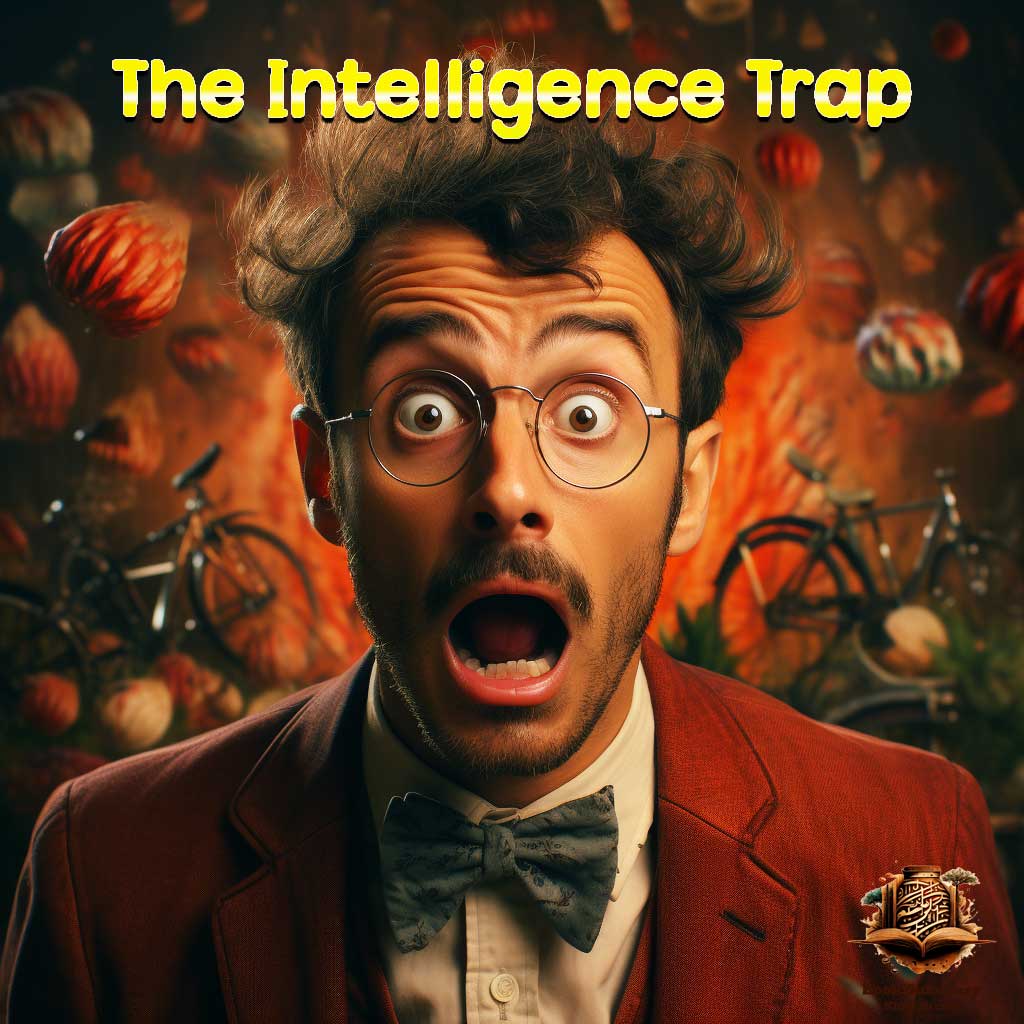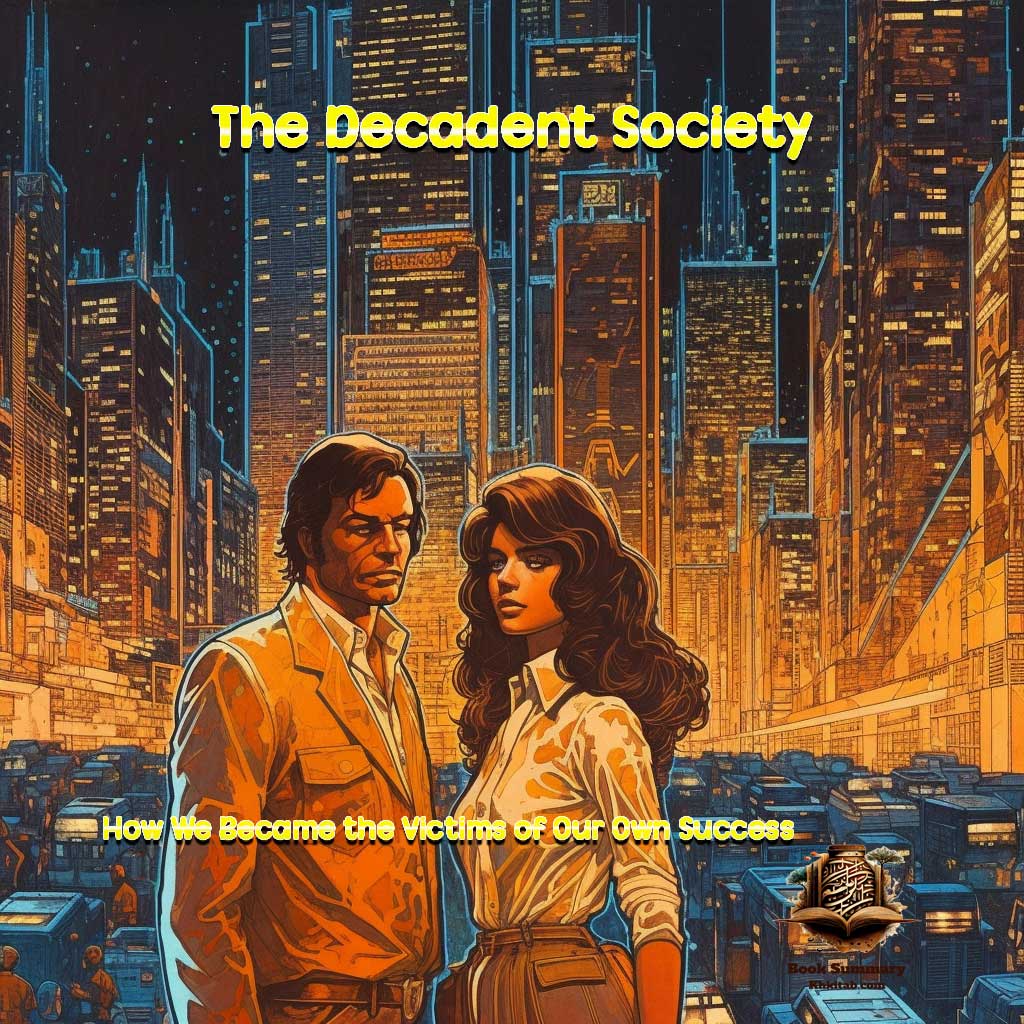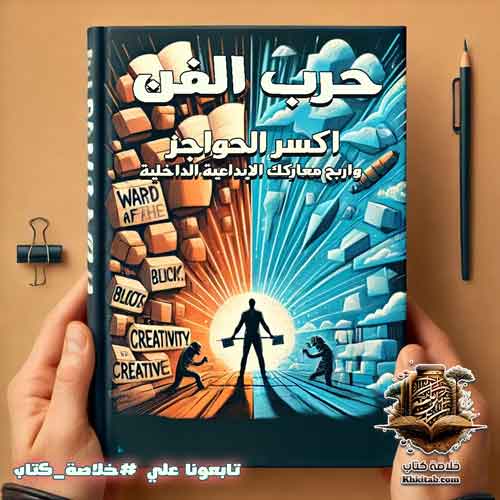The Intelligence Trap: Why Smart People Make Dumb Mistakes and How to Avoid Them Book Summary

In the expanded introduction to “The Intelligence Trap: Why Smart People Make Dumb Mistakes and How to Avoid Them,” author David Robson invites us into a thought-provoking examination of intelligence from an unconventional angle. He posits that being smart doesn’t necessarily safeguard against folly; in fact, intelligent people can be especially susceptible to making unwise decisions and irrational actions.
This introduction ushers us into the crux of Robson’s argument, illustrating that intelligence, often seen as a beacon of problem-solving and successful outcomes, can sometimes complicate situations rather than simplify them. The book offers a plethora of historical anecdotes and scientific studies that underpin Robson’s thesis, demonstrating how even the intellectually gifted can fall prey to the very cognitive traps and biases he dissects in depth.
With eloquence, Robson demonstrates how intelligence without self-awareness and intellectual humility can bolster confirmation biases and a resistance to new ideas, thus hampering an individual’s ability to learn and accept differing viewpoints. “The Intelligence Trap” not only invites readers to reflect but also serves as a step-by-step guide towards understanding how our mental faculties can be harnessed to make wiser decisions, navigating the complexities of modern life with greater efficacy and insight.
إقرأ أيضا:Purple Cow: Standing Out in the Competitive Digital AgeThis book is not merely a call to thought; it’s a manual that walks readers through a journey of realizing how the human mind can transform its mental prowess into tools for enhanced decision-making, opening new horizons for understanding and engaging with the world around us.
Can High IQ Guarantee Wise Decisions? Unpacking the Fallibility of Intelligence
In David Robson’s insightful book “The Intelligence Trap: Why Smart People Do Stupid Things and How to Avoid Them,” he delves into the intriguing aspect of how a high IQ is not a definitive shield against making poor decisions. One might assume that intelligence equates to a consistent ability to navigate life without error. However, Robson’s exploration reveals a more nuanced reality.
The concept of intelligence fallibility is central to understanding the limitations of a high IQ. It’s a common misconception that smarter individuals are inherently equipped to make superior choices. Yet, Robson presents compelling evidence that high-IQ individuals are sometimes more prone to errors in judgment than their less intellectually gifted counterparts.
One of the primary reasons for this paradox is that intelligence can foster a sense of overconfidence. Highly intelligent individuals may become so assured in their cognitive abilities that they overlook the necessity of double-checking facts or considering alternative viewpoints. This overconfidence often leads to a phenomenon known as the ‘blind spot,’ wherein smart people fail to recognize the gaps in their knowledge or the potential biases in their thinking.
Furthermore, Robson explains that high intelligence can sometimes lead to a complexity bias, where simple solutions are overlooked in favor of more complicated ones. This is because intelligent people are often drawn to complexity and may unconsciously believe that a more complex answer is more correct, even when it isn’t.
Another factor contributing to the fallibility of intelligence is the tendency to employ motivated reasoning. This means that individuals use their intelligence to argue for what they want to be true, rather than what is actually true. They may skillfully craft arguments that support their desired conclusion, all the while neglecting evidence that contradicts it.
Robson’s book stresses the importance of recognizing these intellectual pitfalls. He argues that the antidote to the intelligence trap is not less intelligence but rather a better application of it. Critical thinking, humility, openness to new ideas, and an awareness of cognitive biases can help intelligent people avoid the trap of their own intellect.
By addressing the fallibility of intelligence head-on, “The Intelligence Trap” serves as a vital resource for anyone looking to navigate the complexities of decision-making in a world where intelligence alone is not enough to guarantee success. It’s a reminder that true wisdom isn’t just about having knowledge; it’s about how you use that knowledge to make informed and reflective decisions.
Life Sciences & Medicine – Book Summary Library (khkitab.com)
Why Are Even the Smartest Among Us Prone to Cognitive Biases?
In the revealing work “The Intelligence Trap: Why Smart People Do Stupid Things and How to Avoid Them,” David Robson engages with the curious contradiction that despite our advanced cognitive abilities, we are all susceptible to errors in judgment and irrational biases. The book takes a deep dive into the cognitive biases and flaws that permeate our thinking processes, even among those who are highly intelligent.
Robson’s thesis pivots on the concept that intelligence and rationality are not one and the same. Smart individuals, often lauded for their analytical prowess, are not immune to the same cognitive biases that affect everyone else. They can fall victim to a range of biases such as confirmation bias, where they focus on information that supports their preconceptions while disregarding contradictory evidence. This tendency is compounded by the intellectual’s habit of engaging in motivated reasoning, a process of constructing a narrative that justifies their beliefs or actions, even in the face of opposing facts.
The book also examines how cognitive biases are reinforced by the way smart people process information. Their intellectual confidence may lead them to be less open to alternative perspectives, creating a feedback loop where their intelligence actually hinders their judgment. Robson calls for a reevaluation of how we approach problems, suggesting that the key to avoiding these traps is not in denying our biases, but in acknowledging them and actively working to mitigate their influence.
He emphasizes the importance of intellectual humility and the recognition that we are all fallible, regardless of our IQ. By fostering an environment where ideas are challenged and debate is encouraged, individuals can protect themselves from the echo chambers that amplify cognitive errors. Robson’s extensive research and engaging narrative combine to paint a picture of how adopting a mindset that is at once critical and open-minded can lead to more robust decision-making.
This exploration is critical in an age where information is abundant and the ability to sift through noise to find truth is paramount. “The Intelligence Trap” offers a roadmap for navigating the complex terrain of human cognition, stressing that awareness and deliberate thought are our best tools against the inherent flaws in our thinking. It’s a resonant reminder that smart does not always equal correct, and that intelligence should be accompanied by the wisdom to recognize its limitations.
Our Facebook Page – Book Summary
How Does Expertise Become a Pitfall for Intelligent Individuals?
When we consider the relationship between expertise and intelligence, we might naturally assume that deep knowledge in a specific area correlates with impeccable judgment and decision-making. However, “The Intelligence Trap: Why Smart People Do Stupid Things and How to Avoid Them” by David Robson provides a nuanced exploration of how, paradoxically, expertise can lead to significant errors in judgment. This counterintuitive phenomenon is at the heart of what Robson terms ‘the intelligence trap’, where an expert’s deep and narrow focus may foster overconfidence and a diminished capacity to appraise situations outside their domain accurately.
Robson delves into the psychology of this trap, examining how being highly knowledgeable can sometimes blind us to our limitations. This blindness often manifests as a cognitive bias known as the ‘curse of knowledge’, where experts fail to see things from the perspective of less knowledgeable individuals, leading to poor communication and decision-making. Moreover, experts can become so entrenched in their own field that they start to apply their deep knowledge too broadly, overlooking the nuances of different contexts and problems.
The book further investigates how the pitfalls of expertise are not just limited to individual cognition but can also affect group dynamics. In groups of highly intelligent and knowledgeable individuals, there’s a risk of ‘groupthink’, where the desire for consensus and the influence of strong leaders can suppress dissenting opinions and critical thinking. This can lead to collective overconfidence and underestimation of risks, as group members validate each other’s expertise and judgments without sufficient critical evaluation.
To avoid the pitfalls of expertise, Robson suggests that we need to foster intellectual humility and a culture of continuous learning. Experts should be encouraged to engage with disciplines outside their field, to collaborate with others, and to question their assumptions regularly. By recognizing the boundaries of one’s expertise and seeking diverse perspectives, intelligent individuals can safeguard against the overconfidence that expertise can breed.
Ultimately, “The Intelligence Trap” serves as an insightful guide on how to balance deep expertise with broad, flexible thinking. It offers strategies for intelligent individuals to become not just specialists, but also adept generalists who can navigate complex problems with wisdom and humility. The book reminds us that intelligence and expertise, while powerful, are most effective when paired with an awareness of our cognitive limitations and a willingness to learn from others.
How Does Over-Intellectualization Lead to Complicating Simple Issues?
In “The Intelligence Trap: Why Smart People Do Stupid Things and How to Avoid Them,” author David Robson delves into the paradox that intellectual individuals often fall into: the compulsion to turn straightforward problems into complex ones, a phenomenon he refers to as ‘over-intellectualization.’ This book provides a compelling examination of why highly intelligent people sometimes fail to solve simple problems and offers insights on how to harness intellectual prowess effectively.
Over-intellectualization is a trap that snags many smart people. They often use their intellectualism as a tool to dissect problems. However, this approach can backfire. The book points out that when a problem is straightforward, adding layers of complexity doesn’t necessarily lead to better solutions; it can obfuscate the issue, making the resolution harder to see.
Robson explains that this tendency is partly because intellectually gifted individuals are trained to look for hidden layers and underlying variables. They are accustomed to complexity and, therefore, might overlook or dismiss the simplicity on the surface. The drive to demonstrate competence and the fear of seeming ‘too simple’ can compel them to overanalyze, leading to decision paralysis or flawed choices.
Furthermore, the book highlights the role of cognitive biases in over-intellectualization. Confirmation bias, for instance, can lead smart people to favor complex solutions that confirm their self-perception as deep thinkers, even when such solutions are not warranted.
The Intelligence Trap provides practical solutions to this conundrum. It suggests that one should apply the principle of Occam’s Razor more rigorously—the idea that the simplest explanation is often the best. It also advocates for intellectual humility, the acknowledgment that one’s knowledge has limits and that sometimes the simplest solution might be the correct one.
Moreover, Robson encourages a multidisciplinary approach to problem-solving. By consulting with peers from different fields, intellectual individuals can gain perspectives that ground their thinking in practicality. He also recommends mindfulness and reflective practices that help individuals recognize when they are overthinking.
In essence, the book serves as a guide for smart individuals to avoid the pitfalls of their intelligence. It encourages them to embrace simplicity when necessary and reserve complexity for where it truly belongs. The goal is not to diminish the value of intellectualism, but to channel it in ways that are appropriate, effective, and constructive. Through this lens, “The Intelligence Trap” not only explores the problems of over-intellectualization but also celebrates the potential for intelligent individuals to apply their minds with clarity and simplicity.
Why Do Smart People Fall Prey to Motivated Reasoning?
In the insightful book “The Intelligence Trap: Why Smart People Do Stupid Things and How to Avoid Them,” author David Robson delves into the perplexing phenomenon of motivated reasoning, where one’s desires and beliefs cloud judgment and logic, leading even the intellectually gifted to make poor decisions.
The crux of motivated reasoning lies in its name — it’s motivation that steers the thinking process, rather than objective evidence or logical reasoning. Smart individuals are not immune to this; in fact, their formidable cognitive skills can serve to construct more elaborate justifications for beliefs they’re emotionally or ideologically attached to. Robson argues that motivated reasoning is a significant pitfall for intelligent people because their advanced rational capabilities allow them to craftily defend biases or flawed beliefs.
For example, a scientist with a strong ideological stance on a contentious issue might unconsciously interpret data through a biased lens, overlooking or undermining pieces of evidence that contradict their stance. This cognitive bias can result in a distorted view of the evidence and can lead to decision-making that is based more on personal beliefs than on factual correctness.
Robson points out that this form of reasoning is not just about being wrong; it’s about being wrong with confidence. The intelligence trap ensnares those who use their intellectual firepower not to seek out truth, but to rationalize pre-existing beliefs and justify decisions made for non-rational reasons. It’s a paradox where smarter individuals have a greater capacity to deceive themselves with sophisticated arguments.
One of the ways “The Intelligence Trap” suggests combating motivated reasoning is through intellectual humility. Recognizing the limits of one’s knowledge and the potential for bias can open up avenues to more balanced thinking. It promotes the idea of actively seeking out opposing viewpoints and engaging with them seriously, rather than dismissing them out of hand.
Additionally, the book highlights the importance of a culture that encourages challenge and critical scrutiny, suggesting that organizations and groups should foster environments where questioning and intellectual conflict are seen as valuable for growth and truth-seeking.
Robson also recommends structured analytical techniques like pre-mortem analysis — where a decision is imagined to have failed, and reasons for the failure are explored beforehand. This helps to counteract overconfidence and allows for more objective analysis.
Ultimately, “The Intelligence Trap” offers a nuanced exploration into how intelligent people can guard against the clever rationalizations that motivated reasoning produces. It underscores the value of critical thinking, the necessity of intellectual humility, and the importance of an environment that challenges and refines thought. For the intelligent individual, it’s a call to use their abilities not just for advocacy but for self-scrutiny and to ensure that their reasoning is as objective and untainted by personal motivations as possible.
How Can Intellectual Humility Save Smart People from Falling into the Intelligence Trap?
“The Intelligence Trap” by David Robson is not just another book about smart people making foolish mistakes; it is an exploration into the psychological journey of intellectual humility and its crucial role in safeguarding against erroneous convictions. One of the central tenets of Robson’s work is that recognizing the boundaries of our own knowledge and valuing others’ input is not merely wise but essential for anyone looking to navigate a complex world without succumbing to the pitfalls of their intellect.
Robson weaves together tales and empirical studies that illuminate how even those with high IQs can fall prey to cognitive biases that lead to poor decision-making. The importance of intellectual humility emerges as a recurring theme, serving as a corrective lens through which we can evaluate and, importantly, correct our thought processes.
Intellectual humility is not about doubting one’s intelligence or being unconfident. Rather, it is the understanding that no matter how intelligent we are, our knowledge has limitations. It is a buffer against the kind of hubris that leads smart people to believe they are immune to error. Robson artfully argues that this trait can and should be cultivated actively, as it can protect against the overconfidence that often accompanies high intelligence.
One striking case Robson discusses involves a group of experts who were blinded by their own knowledge. Their expertise became their downfall as they failed to consider alternative possibilities, leading to disastrous outcomes. This is where intellectual humility could have played a crucial role. By acknowledging that they didn’t have all the answers, they might have sought out additional perspectives and avoided the ‘intelligence trap’.
Robson also details strategies for fostering intellectual humility, such as engaging with diverse viewpoints, actively questioning our own assumptions, and reflecting on the cognitive biases that sway our judgment. For instance, engaging with people who disagree with us can expose the blind spots in our thinking. This doesn’t mean accepting every contrary opinion but rather giving them due consideration and using them as a tool to sharpen our own thinking.
Moreover, “The Intelligence Trap” highlights how smart people can use structured analytical techniques, like red teaming, to challenge their own ideas and preconceptions. This approach involves a team dedicated to finding flaws in a plan or argument, encouraging a culture of debate and constructive criticism.
In a culture that often equates intelligence with infallibility, Robson’s call for intellectual humility is both refreshing and necessary. By integrating these principles into our thinking, we can all avoid the intelligence trap and make decisions that are not only smarter but wiser. The book ultimately serves as a guide for the intelligent individual to navigate the world with a balance of confidence and caution, ensuring that their intellect is a tool for discovery and progress, rather than a hindrance.
How Can Critical Thinking Strategies Prevent Smart People from Falling into the Intelligence Trap?
In the thought-provoking book “The Intelligence Trap: Why Smart People Do Stupid Things and How to Avoid Them,” author David Robson explores an array of techniques and practices that can enhance our decision-making abilities and safeguard us from common cognitive pitfalls. These strategies aren’t just theoretical; they are practical tools that we can apply in everyday situations to avoid the oversights that even the brightest individuals can make.
One of the central themes that Robson delves into is the concept of critical thinking as a protective measure against the intelligence trap. He argues that intelligence alone is not enough to prevent smart people from making poor decisions; instead, a suite of critical thinking skills is required to navigate the complex landscape of modern life.
Robson highlights several key strategies for fostering critical thinking:
- Consideration of Alternative Perspectives: One way to avoid falling into the trap of overconfidence in one’s intelligence is to actively seek out and consider alternative viewpoints. This process involves engaging with ideas that challenge our preconceptions and opening ourselves to new ways of thinking.
- Structured Analytical Techniques: The author discusses structured analytical techniques such as “pre-mortem” analysis, where individuals imagine that a project has failed, and then work backward to determine what might lead to such an outcome. This helps in identifying potential problems before they occur.
- The Red Team Approach: Similar to the pre-mortem analysis, the “red team” approach involves creating a group that is tasked with finding faults or problems in plans or strategies. This adversarial system is designed to encourage critical examination and to ensure that all angles are considered.
- Mindfulness and Reflection: Regular reflection on one’s thought processes and decisions can help to identify biases and flawed reasoning patterns. Mindfulness meditation has been shown to increase self-awareness, which is key to recognizing when we may be falling into thinking traps.
- Intellectual Humility: Recognizing the limits of one’s knowledge and the potential for error can help maintain a healthy perspective on one’s intellectual abilities. This humility prevents the kind of hubris that can lead to significant mistakes.
- Continuous Learning: The commitment to lifelong learning helps keep the mind sharp and open to new information, which is crucial for critical thinking. By continuously updating and revising our knowledge base, we prevent the stagnation of our thought processes.
- Engagement with Opposing Views: Deliberately engaging with people who hold opposing views can strengthen our ability to analyze our own positions and avoid echo chambers that reinforce our preconceptions.
- Fostering a Growth Mindset: A growth mindset, as opposed to a fixed mindset, allows individuals to view challenges as opportunities for growth rather than insurmountable obstacles, encouraging ongoing development and adaptation.
By integrating these strategies into our thinking, Robson suggests that we can better recognize and navigate the intelligence trap. Critical thinking, as presented in “The Intelligence Trap,” is not about doubting our intellect but about exercising it with caution and humility. It’s a skill set that complements raw intelligence, ensuring that our cognitive abilities lead us to wise and well-considered decisions rather than unexamined assumptions and costly errors.
How Does ‘Dysrationalia’ Explain Rational Failures Among Intelligent People?
In “The Intelligence Trap: Why Smart People Do Stupid Things and How to Avoid Them,” author David Robson delves into the puzzling phenomenon of why individuals with high intellectual capabilities sometimes make illogical decisions—a concept he refers to as ‘dysrationalia.’ This term, originally coined by psychologist Keith Stanovich, suggests that a gap can exist between a person’s cognitive ability and their rationality. This gap can lead to actions and decisions that are irrational, despite the individual’s intelligence.
Robson’s exploration of ‘dysrationalia’ is pivotal in understanding that intelligence is not a sole guardian against poor reasoning or bad decision-making. He argues that smart individuals can possess cognitive biases and logical blind spots that impair their judgment. Dysrationalia occurs when individuals fail to apply their intelligence in a rational way. This is often due to overreliance on intuitive thinking or failing to override initial impulses with critical thought.
One of the critical insights from the book regarding ‘dysrationalia’ includes:
- The Misapplication of Cognitive Resources: Intelligent individuals may sometimes use their cognitive resources ineffectively, misapplying their intelligence in ways that are counterproductive. For example, someone might use complex arguments to defend a position that is fundamentally flawed, simply because they are capable of constructing those arguments, not because they are correct.
- Cognitive Miserliness: This is the tendency to choose the least demanding cognitive route, often relying on intuition rather than engaging in more effortful, analytical thinking. People, regardless of their IQ, can be cognitive misers, especially under time pressure or when dealing with complex information.
- Rational Overconfidence: Intelligence can sometimes lead to an unjustified sense of confidence in one’s own reasoning abilities, making individuals less likely to question their judgments or consider alternative viewpoints.
Robson doesn’t just diagnose the problem; he also offers solutions to mitigate the impact of ‘dysrationalia’. He emphasizes the importance of critical thinking and reflective practice, as well as the need for intellectual humility. He also promotes the idea of ‘mindware training,’ which involves equipping people with the tools and techniques to think more rationally, such as probability theory and cost-benefit analysis.
Moreover, Robson highlights the role of educational systems in addressing ‘dysrationalia.’ He suggests that alongside teaching traditional intelligence-based skills, education should also focus on rational thinking skills. By doing so, individuals will be better prepared to apply their intelligence in ways that foster sound reasoning and rational decision-making.
Understanding ‘dysrationalia’ is fundamental for anyone looking to navigate a complex world with judiciousness. By recognizing the limits of intelligence alone and fostering the skills necessary for rational thinking, people can avoid the pitfalls of ‘The Intelligence Trap’ and make decisions that are not just smart, but also wise.
How Does Emotional Intelligence Guard Against ‘The Intelligence Trap’?
In the critically acclaimed book “The Intelligence Trap: Why Smart People Do Stupid Things and How to Avoid Them,” author David Robson delves into the often-overlooked realm of emotional intelligence and its crucial role in protecting us from the pitfalls of our own intellect. Robson presents a compelling argument: while a high IQ can open the doors to many successes, it is emotional intelligence that equips us with the tools to navigate through those doors without stumbling over our own feet.
Robson deftly explains that emotional intelligence, the ability to understand and manage our own emotions and those of others, plays a pivotal role in our reasoning process. It influences how we interpret information, make decisions, and interact with the world. In essence, it is a safeguard against ‘The Intelligence Trap’ — the phenomenon where individuals with high intellectual capabilities make illogical or poor decisions due to a lack of self-awareness, overconfidence, or the inability to process emotional undercurrents in complex situations.
Throughout “The Intelligence Trap,” we are introduced to real-life scenarios and scientific studies that illustrate how individuals with heightened emotional awareness are less likely to fall prey to cognitive biases that often ensnare even the brightest minds. For instance, the ability to recognize when one is affected by emotions like anger or frustration can prevent the kind of tunnel vision that leads to poor judgement.
Furthermore, the book highlights the importance of empathy in reasoning. By being able to step into someone else’s shoes, emotionally intelligent people can view problems from multiple perspectives, leading to more nuanced and effective solutions. This is not just speculation; research shows that teams with a higher collective emotional intelligence are more capable of successful collaboration and innovation.
Robson’s examination into emotional intelligence provides a strong case for its inclusion in personal development and educational programs. It’s not enough to be smart; to avoid ‘The Intelligence Trap,’ we must also learn to be emotionally adept. This is perhaps one of the most transformative messages of the book, pushing the reader to not only recognize the importance of emotional intelligence but to actively cultivate it as a counterbalance to raw intellect.
In summary, “The Intelligence Trap” not only enlightens us on the importance of emotional intelligence as a critical component of effective thinking and decision-making, but also as an essential skill for the 21st century, where emotional complexities often dominate both personal and professional spheres. Robson’s book encourages us to embrace a more holistic view of intelligence — one that integrates both the mind and the heart.
How Can Mindware Training Enhance Our Problem-Solving Abilities?
In the insightful book “The Intelligence Trap: Why Smart People Do Stupid Things and How to Avoid Them,” the concept of mindware training is presented as a transformative approach to upgrading our mental ‘software.’ The term ‘mindware’ refers to the tools and techniques that we can use to process information more effectively, make better decisions, and solve problems more efficiently.
Author David Robson makes the compelling case that while raw intelligence is a valuable asset, it’s the strategies and frameworks we employ that truly empower us to use our cognitive resources to their fullest potential. Mindware training, therefore, involves equipping oneself with an arsenal of mental models, heuristics, and structured thinking processes to navigate the complex landscape of information that bombards us daily.
Robson delves into how critical thinking frameworks can help us evaluate information critically, and how decision-making strategies, like probabilistic thinking, can aid in making better predictions about future outcomes. He also emphasizes the significance of cognitive biases and how awareness and understanding of these biases can lead to the development of counteractive strategies.
One of the key messages from “The Intelligence Trap” is that intelligence alone is not enough to avoid the pitfalls of poor reasoning. Through mindware training, individuals can cultivate a mindset that values the deliberate application of these cognitive tools, leading to enhanced reasoning abilities. For instance, learning to recognize when to employ a specific problem-solving technique, or which mental model is most applicable in a given scenario, can be the difference between a wise decision and a foolish mistake.
The book suggests that by engaging in regular practice and challenging our minds with diverse problems, we can reinforce these mindware strategies, making them more accessible and natural to us in times of need. Ultimately, Robson’s exploration into mindware training presents a persuasive argument for the ongoing development of our mental ‘software,’ asserting that it is a continual process that can lead to greater wisdom and fewer mistakes, regardless of our innate intelligence level.
How Does Adopting a Growth Mindset Impact Our Learning and Adaptability?
In the insightful exploration within “The Intelligence Trap: Why Smart People Do Stupid Things and How to Avoid Them,” there is a profound discussion on the impact of adopting a growth versus a fixed mindset. Author David Robson delves into how the belief in the ability to grow intelligence can fundamentally alter the way we approach challenges, learning, and adaptability.
Robson highlights the concept of a ‘growth mindset,’ coined by psychologist Carol Dweck, which is the belief that intelligence is not static but can be developed through dedication and hard work. This mindset encourages individuals to embrace challenges, persist in the face of setbacks, and see effort as the path to mastery. In contrast, a ‘fixed mindset’ leads to the belief that intelligence is an innate ability that cannot be changed in any meaningful way.
The book argues that a growth mindset is not only beneficial for personal development but also essential for avoiding the intelligence trap. Smart people can fall into the trap of believing in their innate abilities so much that they become resistant to feedback, avoid challenges, and fear failure, which in turn hampers their growth and adaptation.
Robson uses a variety of real-life examples and scientific studies to demonstrate how the growth mindset leads to a greater willingness to take calculated risks, a higher resilience to frustration, and a more consistent approach to lifelong learning. For instance, individuals who see intelligence as malleable are more likely to engage in reflective practices, seek out constructive criticism, and adapt their strategies when faced with new information or failures.
Moreover, “The Intelligence Trap” discusses how educational systems and workplaces that foster a growth mindset create environments where mistakes are seen as learning opportunities rather than indicators of incompetence. This perspective allows for a healthier approach to learning and problem-solving, where the focus is on progress and improvement rather than proving one’s intelligence.
The takeaway from this segment of the book is clear: by cultivating a growth mindset, we unlock the potential for continuous learning and adaptability. This, in turn, enables us to make better decisions, overcome obstacles more effectively, and avoid the complacency that can come with a fixed mindset. Robson’s examination suggests that whether in personal development or professional endeavors, the growth mindset can be a key factor in achieving success and avoiding the pitfalls that even the smartest individuals can encounter.
Why Does Cognitive Diversity Lead to Better Decision-Making?
In “The Intelligence Trap: Why Smart People Make Stupid Mistakes and How to Make Wiser Decisions,” the author David Robson delves into the concept of cognitive diversity and its profound impact on decision-making and problem-solving. Robson posits that when individuals or groups embrace a multiplicity of perspectives, they are better equipped to navigate complex situations and reach more nuanced and effective solutions.
Cognitive diversity refers to the inclusion of people who have different ways of thinking, problem-solving, and perceiving the world. Robson explains that this diversity shouldn’t be confined to professional environments or creative endeavors; it’s equally important in our everyday decision-making processes.
The author outlines how cognitive diversity can prevent groupthink—a phenomenon where the desire for harmony in a group leads to irrational or dysfunctional decision-making. By bringing together varied viewpoints, groups can counteract the echo chamber effect, where only similar perspectives are heard and reinforced.
Robson illustrates this with real-world examples, including how teams of mixed abilities often outperform groups of high-ability individuals in problem-solving tasks. This is because diverse groups tend to challenge each other more, leading to a deeper analysis of issues and a more rigorous evaluation of potential solutions.
Moreover, cognitive diversity fosters a culture of learning and adaptability. Individuals who are exposed to differing viewpoints are more likely to revise their own views in light of new evidence or arguments. This flexibility is crucial in a fast-paced world where the ability to pivot and adapt can be the difference between success and failure.
In “The Intelligence Trap,” there’s a particular emphasis on the benefits of intellectual humility. Recognizing the limits of one’s knowledge and being open to others’ insights is shown to be a hallmark of wise decision-makers. Robson argues that cognitive diversity encourages this humility and a departure from intellectual overconfidence, which can lead to the very “intelligence traps” the book warns against.
The key takeaway from the book is that cognitive diversity isn’t just about social equity or fairness—it’s a strategic advantage. It enables individuals and organizations to approach problems from multiple angles, anticipate different potential challenges, and arrive at more robust, well-rounded solutions.
In conclusion, Robson’s “The Intelligence Trap” suggests that by actively seeking out and valuing cognitive diversity, we can enhance our collective intelligence, avoid common pitfalls of solo or homogenous thinking, and make wiser decisions in both personal and professional spheres.
Why Does the Intelligence Trap Have Far-Reaching Effects on Society?
In “The Intelligence Trap: Why Smart People Do Stupid Things and How to Avoid Them,” author David Robson delves into the pervasive impact that cognitive missteps of intelligent individuals have on society at large, from politics to business and education. The intelligence trap isn’t just about individual blunders; it’s a societal phenomenon with far-reaching consequences.
Robson presents a compelling narrative that intelligent people often fall into the intelligence trap because they misuse their cognitive resources, leading to flawed reasoning and poor decisions. These errors can have significant ramifications in various societal domains:
Politics: In the political arena, the intelligence trap can manifest when smart leaders become overconfident in their judgments, fail to seek diverse opinions, or become entrenched in their belief systems, neglecting evidence that contradicts their views. This can result in policies that are not well-thought-out or that fail to address the needs of the populace effectively.
Business: In the business world, executives and entrepreneurs might fall into the trap by relying too heavily on their expertise and failing to adapt to new information or changing market conditions. This could lead to strategic missteps, overlooking potential risks, or missing out on innovative opportunities.
Education: The education sector is not immune to the intelligence trap either. Educators and policymakers might cling to outdated teaching methods or educational theories, despite new research suggesting better approaches, potentially hindering student development and learning outcomes.
Robson argues that the antidote to the intelligence trap in these fields is a combination of metacognitive strategies, such as reflective thinking and intellectual humility, and systemic changes that promote cognitive diversity and constructive criticism.
The real-world implications of the intelligence trap are profound because decisions made in these domains can shape the lives of millions. For instance, when politicians ignore counterarguments, the result can be policies that fail to address key issues or that exacerbate existing problems. In business, a leader’s inability to recognize their cognitive biases can lead to poor financial decisions, affecting the livelihoods of employees and stakeholders.
In education, teachers who do not engage with new pedagogical research may continue using ineffective teaching methods, impacting student engagement and learning. Robson suggests that by understanding the dynamics of the intelligence trap, individuals and institutions can foster environments where critical thinking and humility are valued, leading to more informed decision-making processes.
In conclusion, “The Intelligence Trap” offers a sobering reminder that high intelligence does not necessarily guard against poor decision-making. By examining the broader implications of this phenomenon, Robson not only provides insights into why smart people make unwise choices but also offers guidance on how societies can better structure themselves to avoid common pitfalls of the intelligence trap, thereby enhancing collective decision-making and progress.
How Does “The Intelligence Trap” Teach Us to Cultivate Practical Wisdom Over Mere Knowledge?
In the thought-provoking book “The Intelligence Trap: Why Smart People Do Stupid Things and How to Avoid Them” by David Robson, an illuminating distinction is drawn between possessing knowledge and applying it wisely—a concept central to practical wisdom. The book unravels the paradox of how individuals with high IQs can still make poor decisions and fall prey to cognitive biases, and it goes further to explore how practical wisdom can be the solution to escaping this intelligence trap.
Robson posits that practical wisdom is not merely about accumulating facts and information; it is the judicious application of knowledge in varied and often uncertain real-life situations. This kind of wisdom requires an adaptive mindset, emotional intelligence, and the capacity for reflective thought. It’s the antidote to the rigid application of ‘book smarts’ in situations that demand more nuanced understanding.
To cultivate practical wisdom, the author suggests embracing strategies that go beyond traditional learning and information processing:
- Reflective Practice: Engaging in reflective practice encourages us to think about our thinking. It involves examining our beliefs, questioning our assumptions, and considering the consequences of our actions.
- Intellectual Humility: Recognizing the limits of our knowledge—what Socrates famously referred to as knowing that we know nothing—allows us to remain open to new information and perspectives.
- Active Open-Mindedness: This is about being willing to change our opinions in the light of new evidence, rather than clinging to outdated beliefs or succumbing to confirmation bias.
- Moral Reasoning: Practical wisdom is deeply intertwined with ethical considerations. Robson highlights the importance of developing moral reasoning skills to ensure our decisions align with our values and the greater good.
- Interdisciplinary Learning: Drawing knowledge from diverse fields enhances our problem-solving abilities by providing multiple lenses through which to view complex issues.
- Experience Diversity: Exposure to a variety of experiences, cultures, and ways of thinking broadens our understanding and enhances our ability to apply knowledge contextually.
- Mentorship and Dialogue: Engaging with mentors and peers in thoughtful dialogue can sharpen our ability to apply knowledge wisely. These relationships provide a forum for challenge and reflection that is crucial for growth.
Robson warns that without practical wisdom, intelligence can be misapplied, leading to errors in judgment and decision-making. For instance, he details scenarios where experts, despite their vast knowledge, failed to foresee the financial crisis or where intelligent leaders persisted with policies that were clearly failing.
Ultimately, “The Intelligence Trap” is a guide for the intellectually gifted and the academically proficient to avoid the pitfalls of smart thinking gone awry. It underlines the importance of not just acquiring knowledge but also developing the discernment to use it wisely. By integrating the strategies outlined for fostering practical wisdom, individuals can not only make better decisions in their personal lives but can also contribute to more informed and effective decision-making in societal and global contexts.








